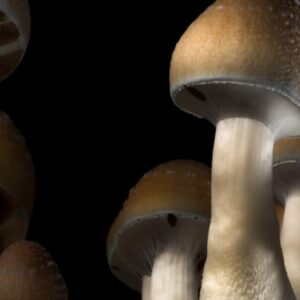Description
Buy Panaeolus cinctulus Online
Buy Panaeolus Cinctulus Online. Panaeolus cinctulus grows optimally in the spring and fall. The mushroom is widespread throughout Europe, as well as the tropics and subtropics (Asia and America). The mushroom thrives in humid conditions and enjoys (horse) manure-fertilized fields. The Panaeolus subbalteatus / cinctulus is originally dark and damp, but as it dries, its center becomes lighter. Therefore, the common name of Panaeolus subbalteatus / cinctulus is the “dark-rimmed Mottlegill.” The mushroom begins its growth with a slightly convex crown, which rapidly flattens out.
The cap diameter of Panaeolus subbalteatus / cinctulus is typically between 2 and 6 centimeters. There are now documented historical applications of this fungus in Western Europe. The Panaeolus subbalteatus / cinctulus fungus contains around 0.7% psilocybin and 0.46 % baeocystin in addition to high levels of serotonin and 5-hydroxytryptophan. It is devoid of psilocin. Orally administered serotonin cannot reach the brain, according to experiments.
Panaeolus cinctulus For Sale Online
Nonetheless, Panaeolus subbalteatus / cinctulus trip reports are distinct from those of mushrooms containing simply psilocybin; they are more empathogenic and aphrodisiac while being highly hallucinogenic. Begin cultivating Panaeolus subbalteatus / cinctulus with our potent grain spawn bags. You may easily cultivate Panaeolus subbalteatus / cinctulus without spores. The production of enchanted mushrooms without complex sterilizing procedures. Discrete international and U.S. shipping — alternative for stealth shipping
Pileus (cap):
4-5 cm broad at maturity. Convex to campanulate, then broadly convex, finally expanding to nearly plane with a broad umbo. Cinnamon brown to orange cinnamon brown, fading to tan in drying with a dark brown encircling zone around the margin.
Lamellae (Gills):
Attachment adnate to uncinate, close, slightly swollen in the centre, and with three tiers of intermediate gills inserted. Color brownish and mottled, with the edges remaining whitish, blackish when fully mature.
Stipe (stem):
50-60 mm long by 2-4 mm thick. Brittle, hollow, and fibrous. Reddish beneath minute whitish fibrils, darkening downwards. Sometimes bruising bluish at the base.
Microscopic features
Spores black in deposit, lemon shaped in side view, subellipsoid in face view.11.5-14 by 7.5-9.5 microns. Basidia 2- and 4-spored. Pleurocystidia absent. Cheilocystidia variable in form, mostly pear shaped, 14-21 by3-7 microns.
Season:
Spring, summer, and fall.
Habitat and Distribution:
Growing in similar habitats as P. semilanceata, Found in horse-inhabited regions and on hay bales that have been abandoned. Additionally, they thrive in grassy areas that have been properly maintained and nourished. In the spring, summer, and early autumn, it grows in dung (particularly horse dung), compost, decomposing hay, and fertile soil. Extensive distribution North America, South America, Europe, middle Siberia, Africa, and the Hawaiian archipelago are represented in this report.




Reviews
There are no reviews yet.